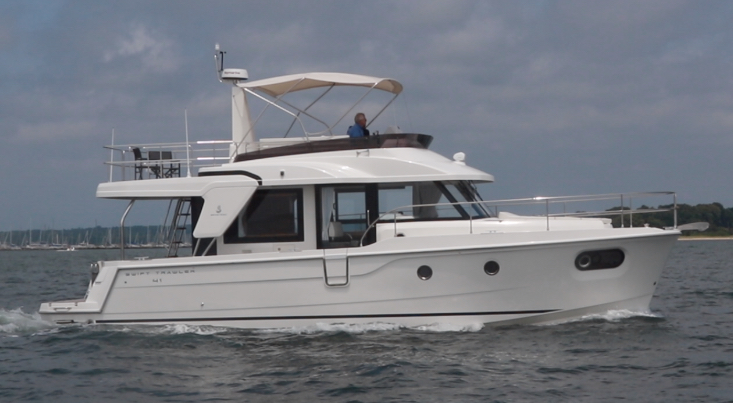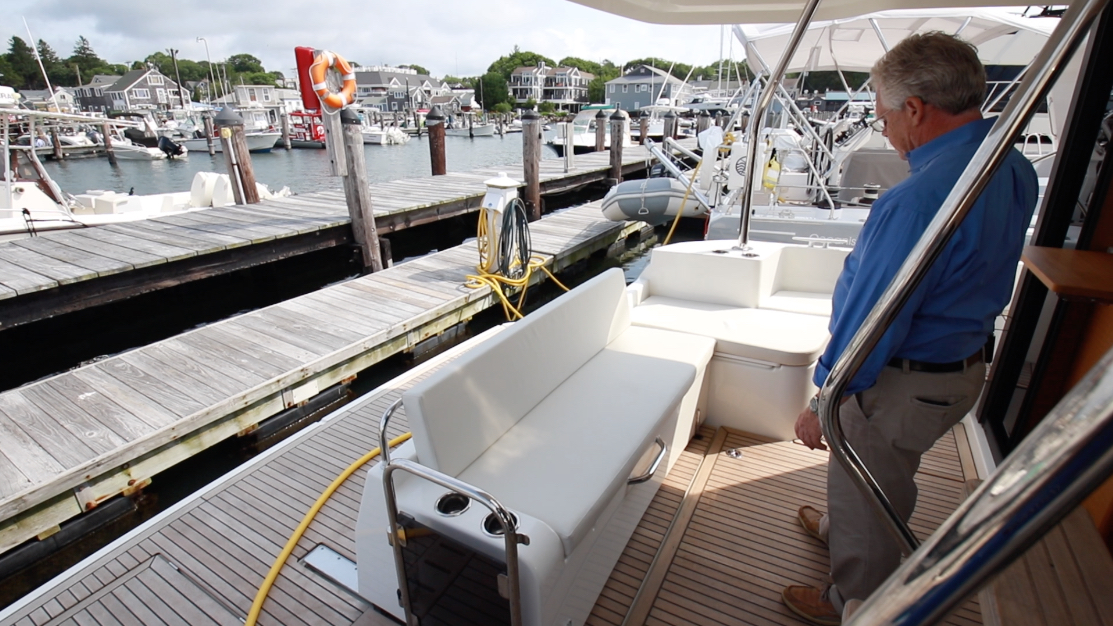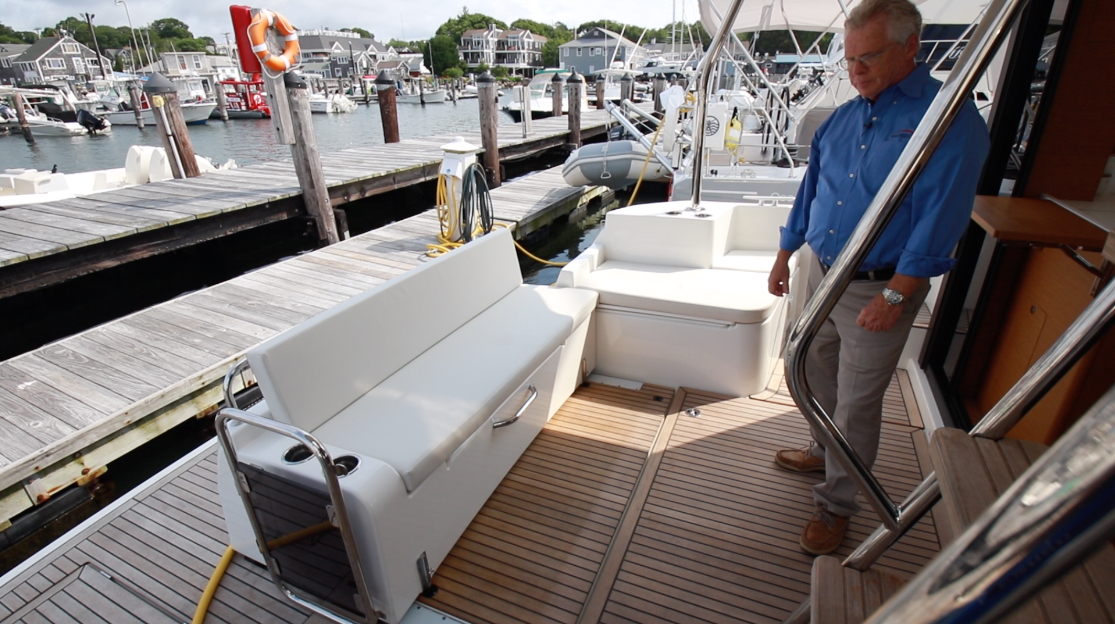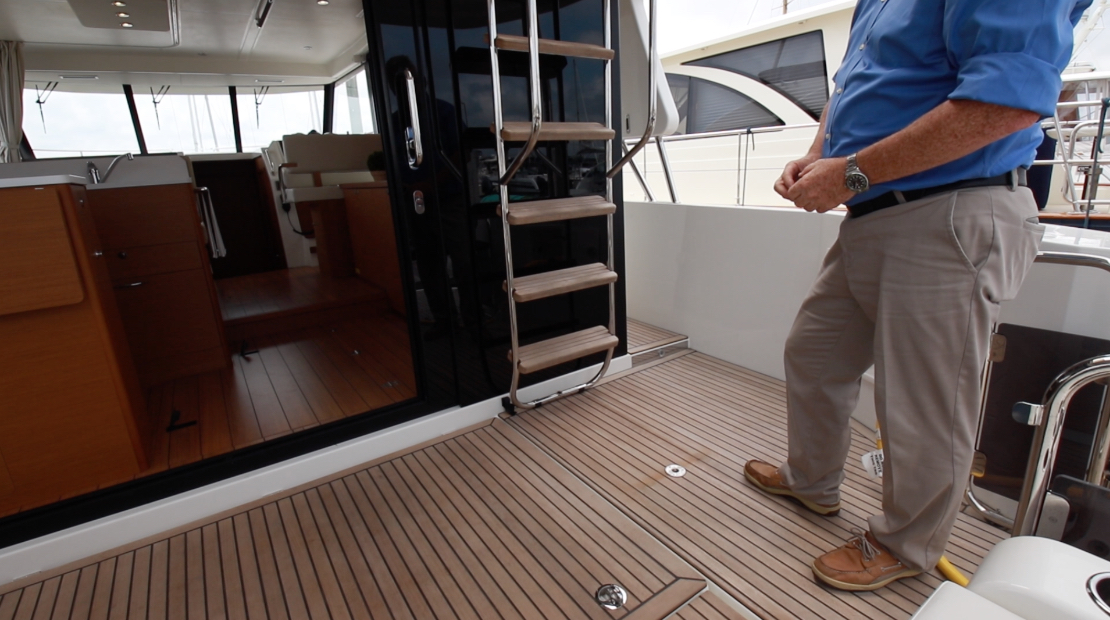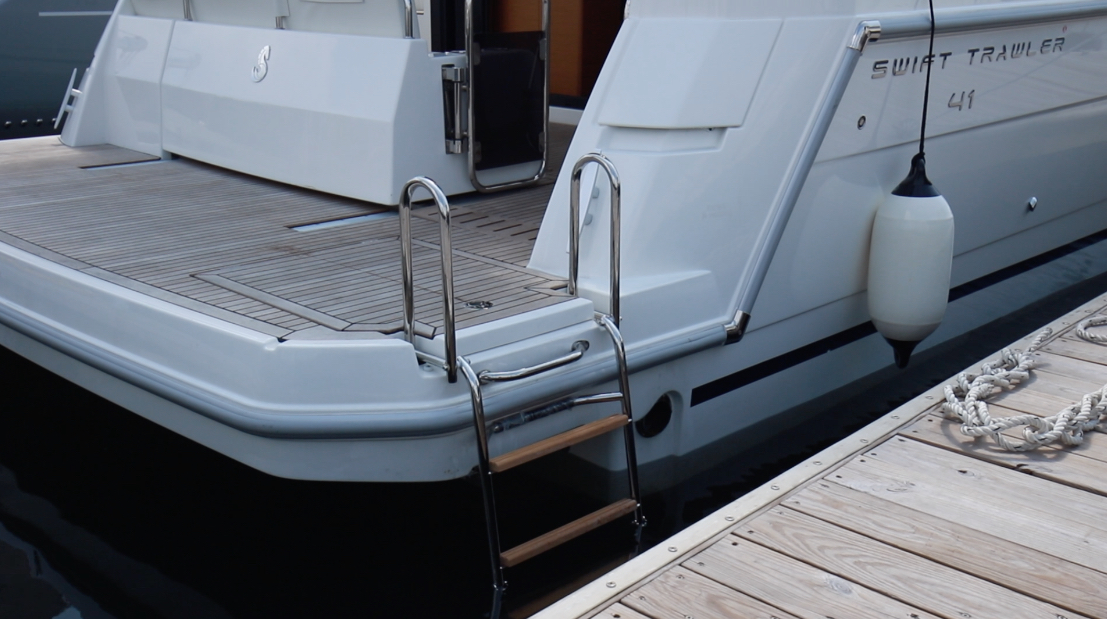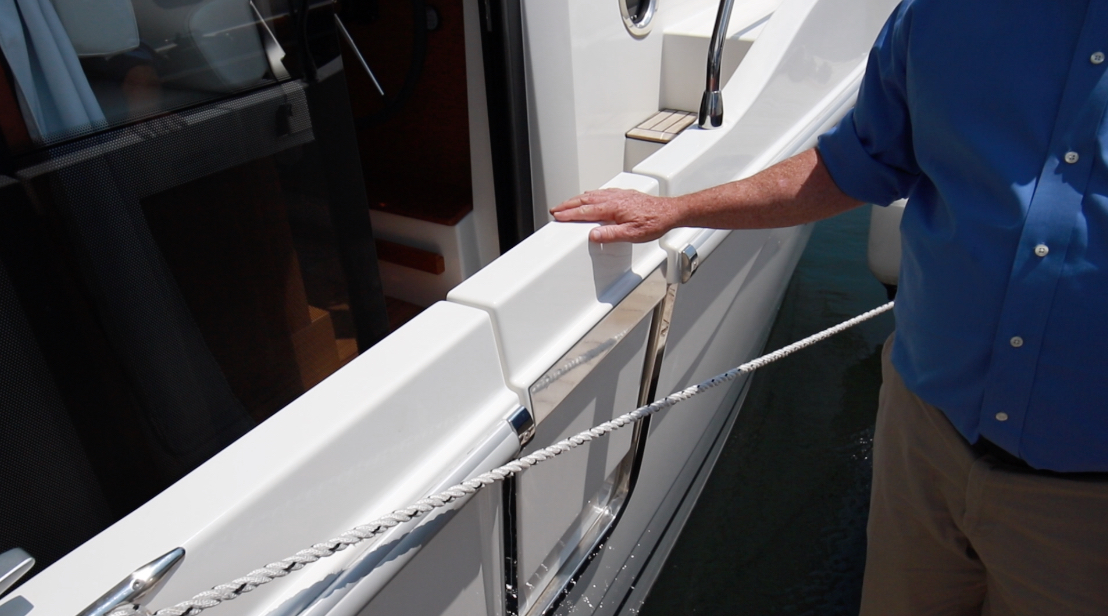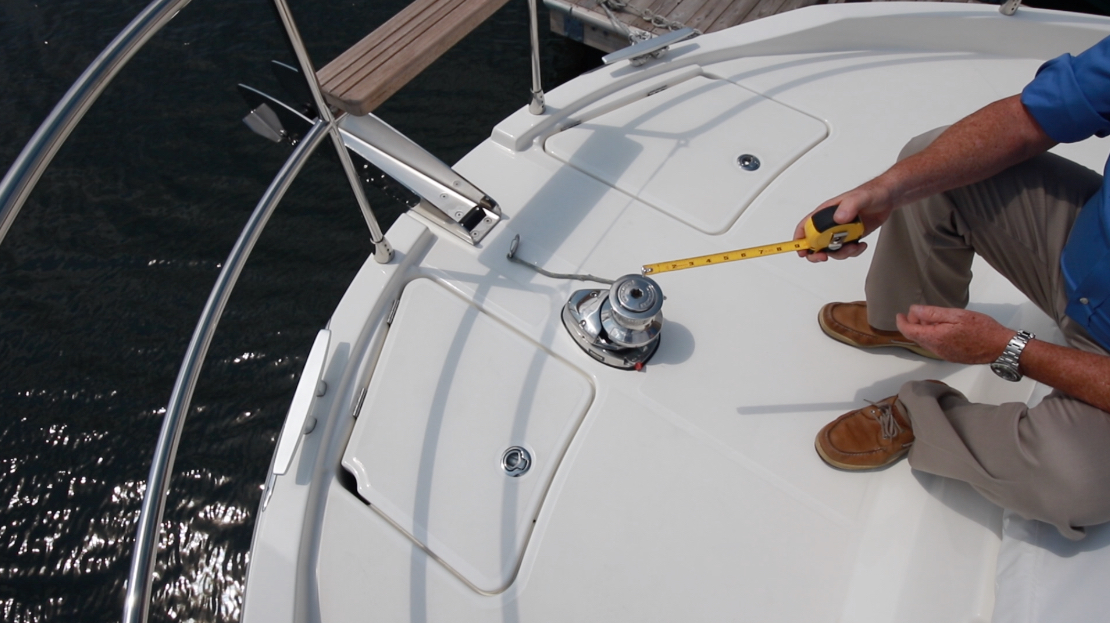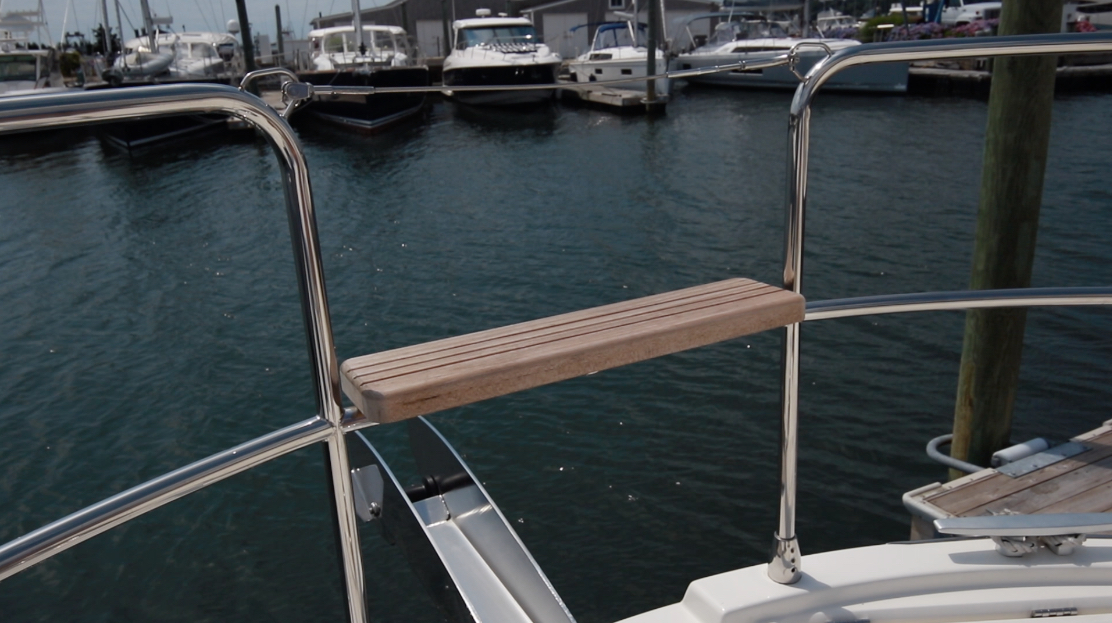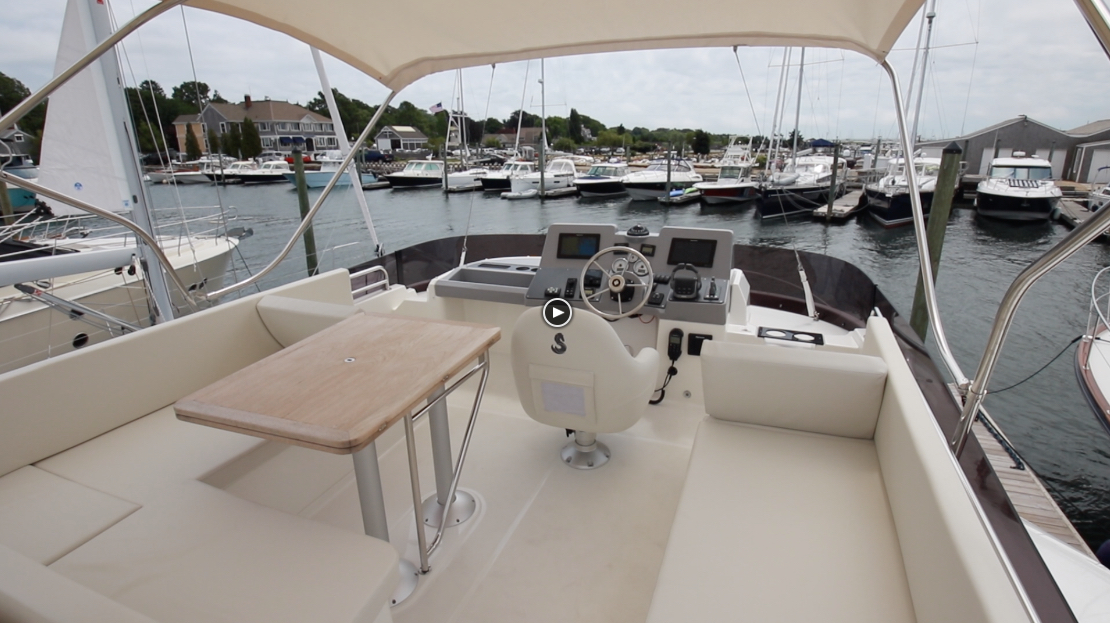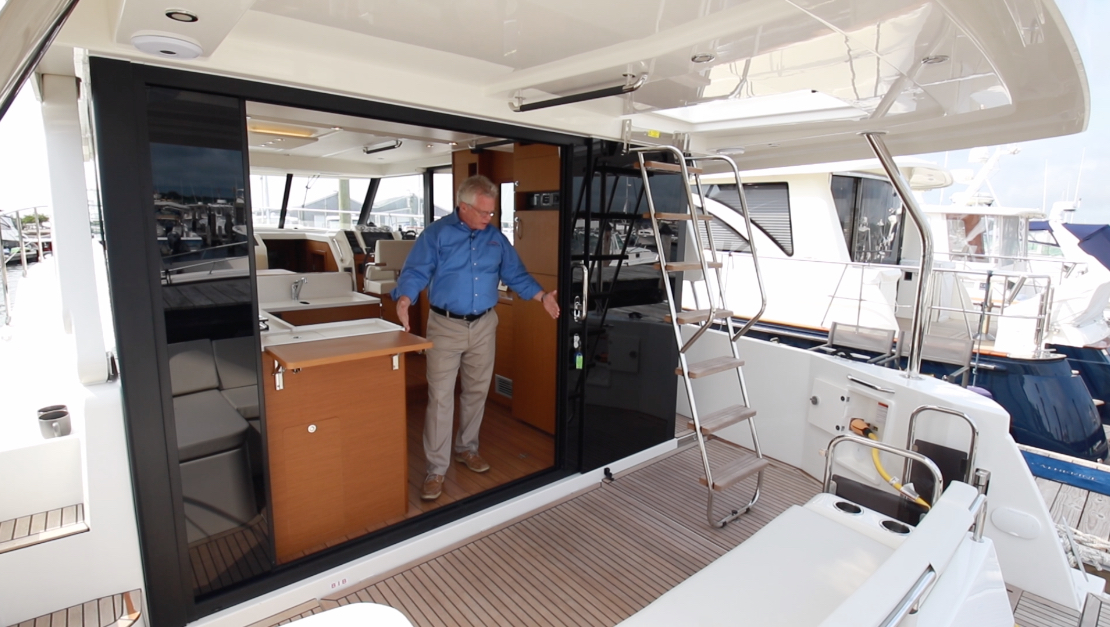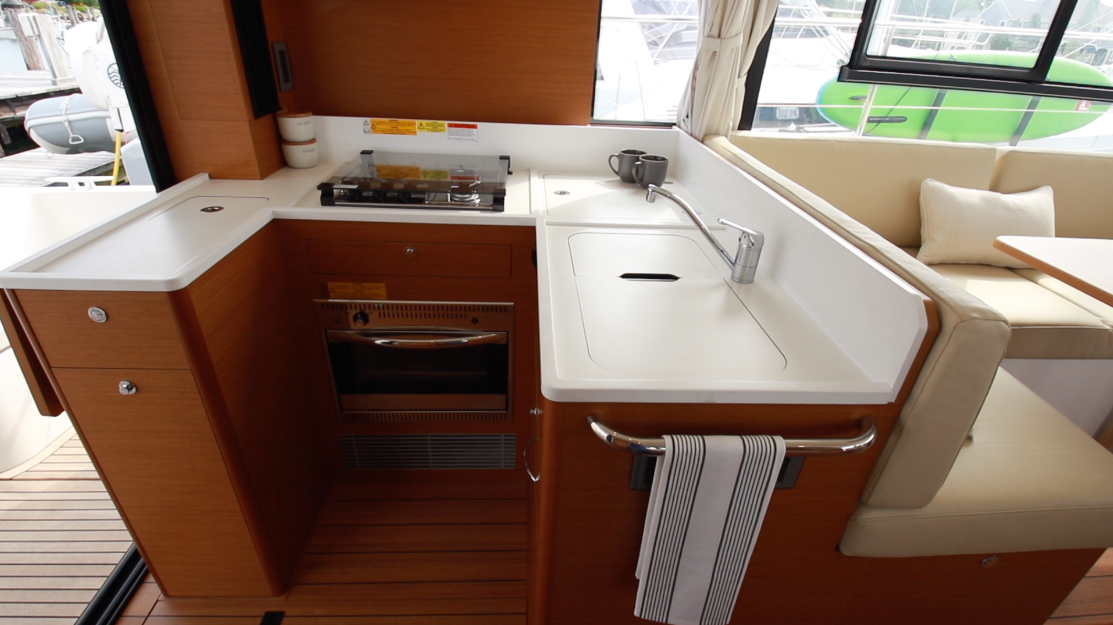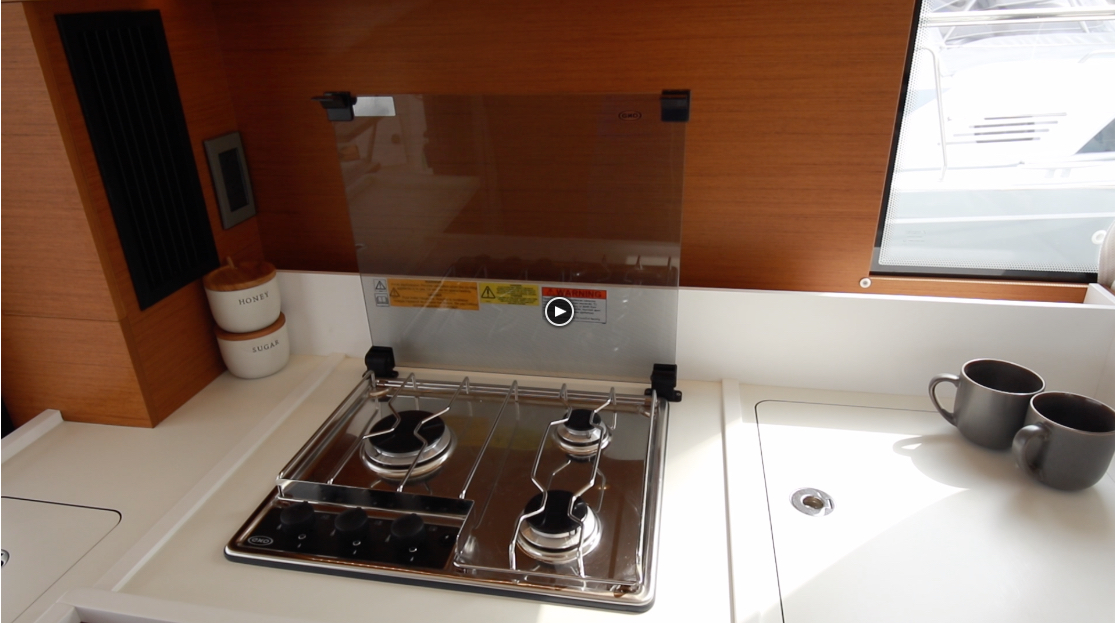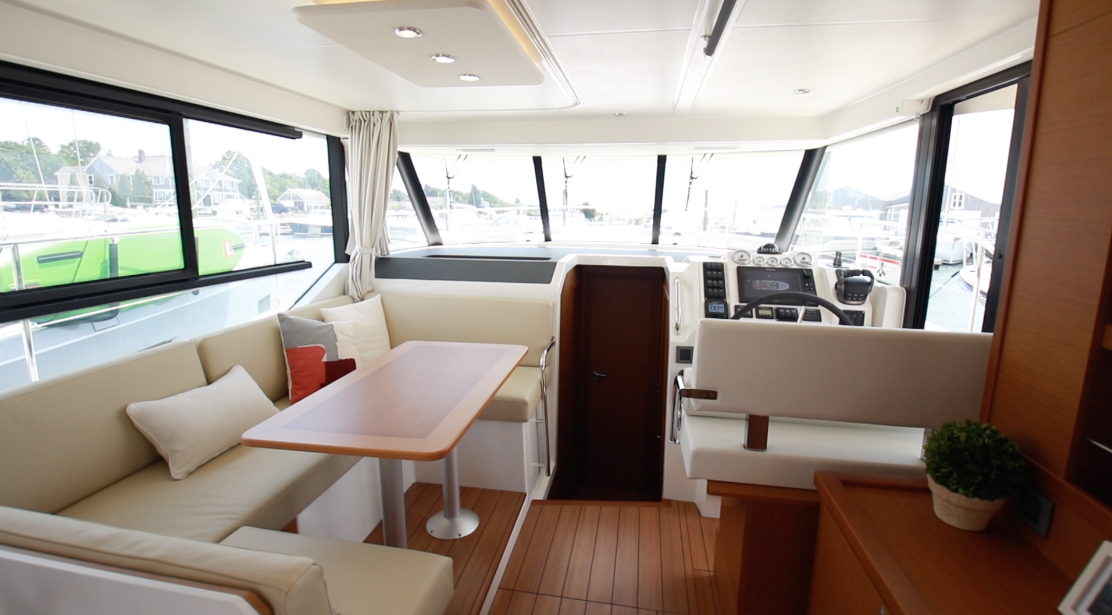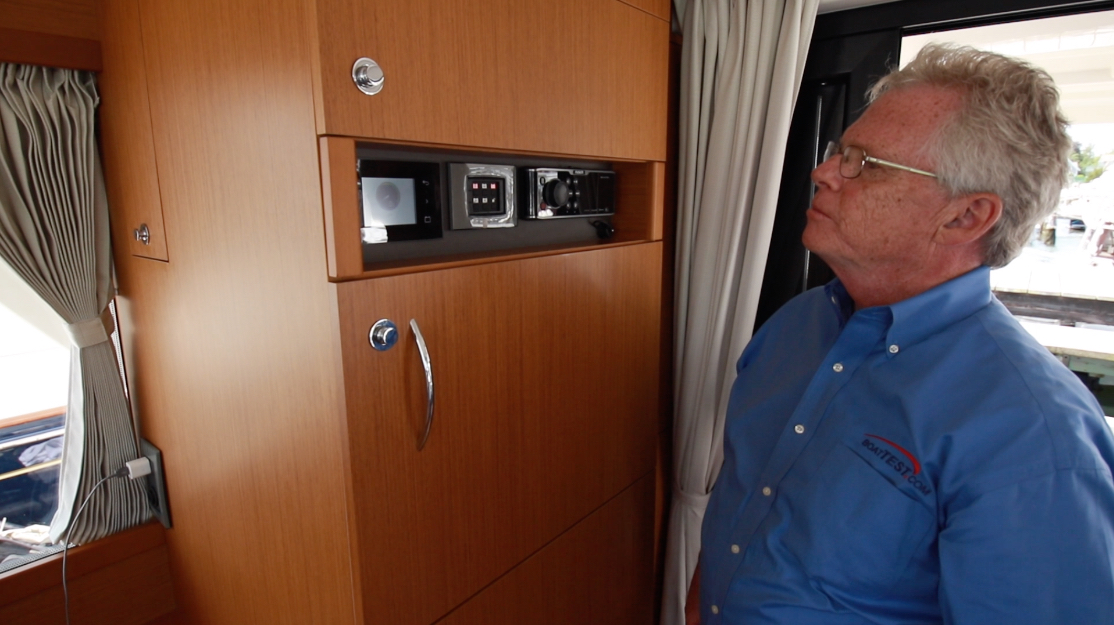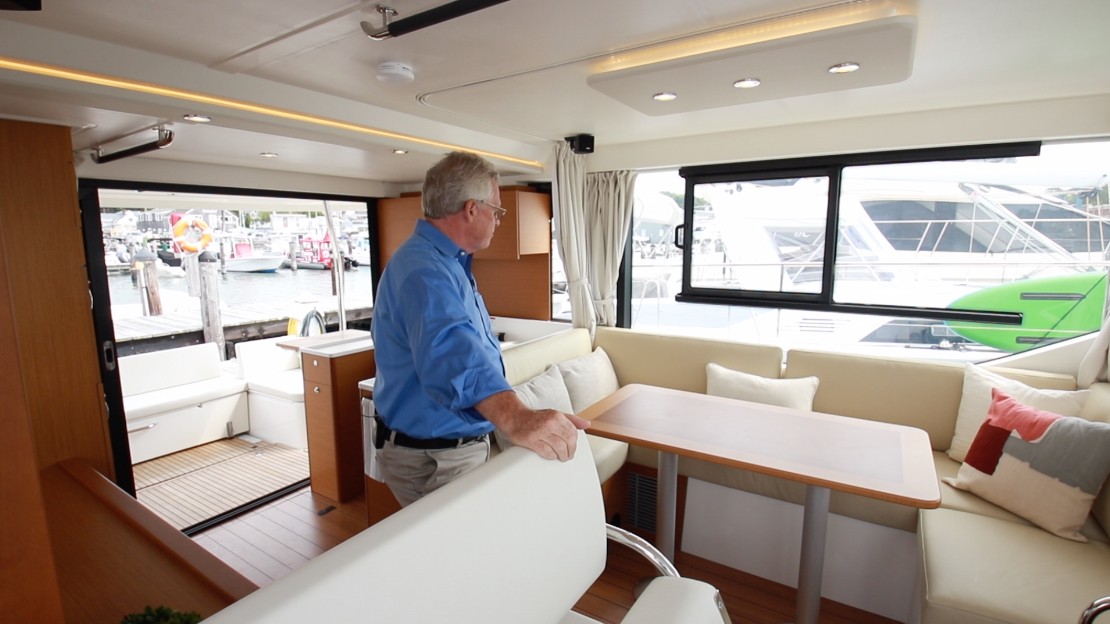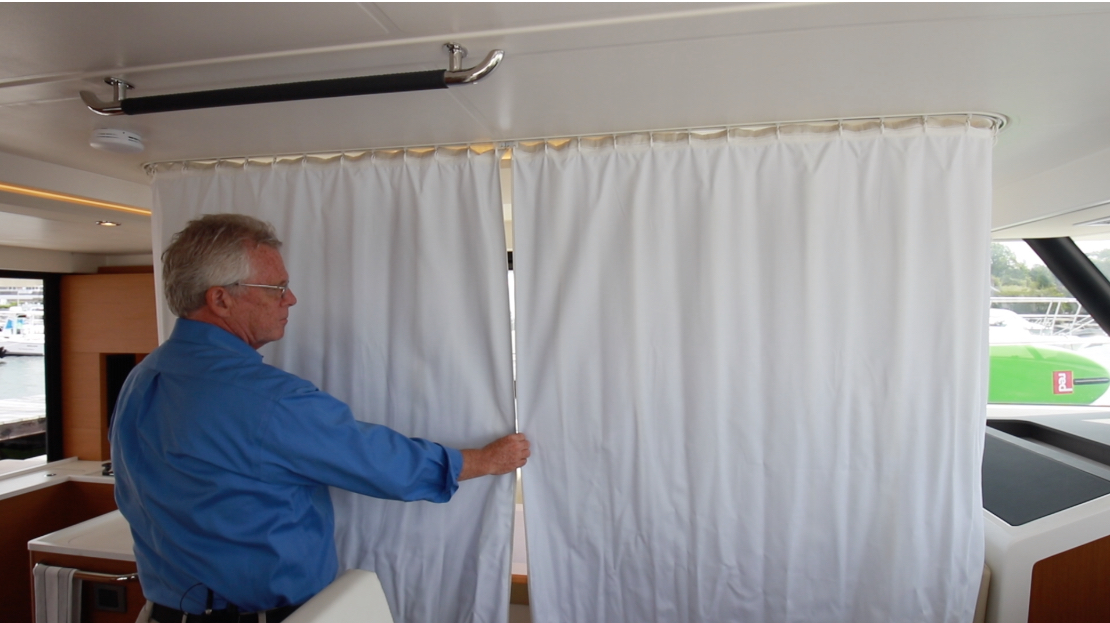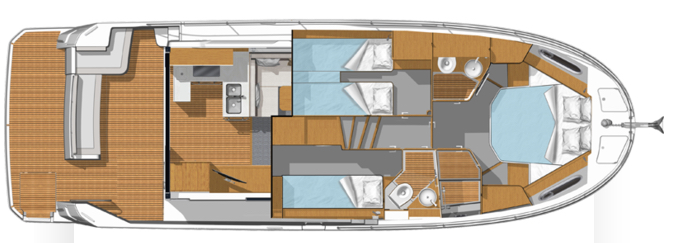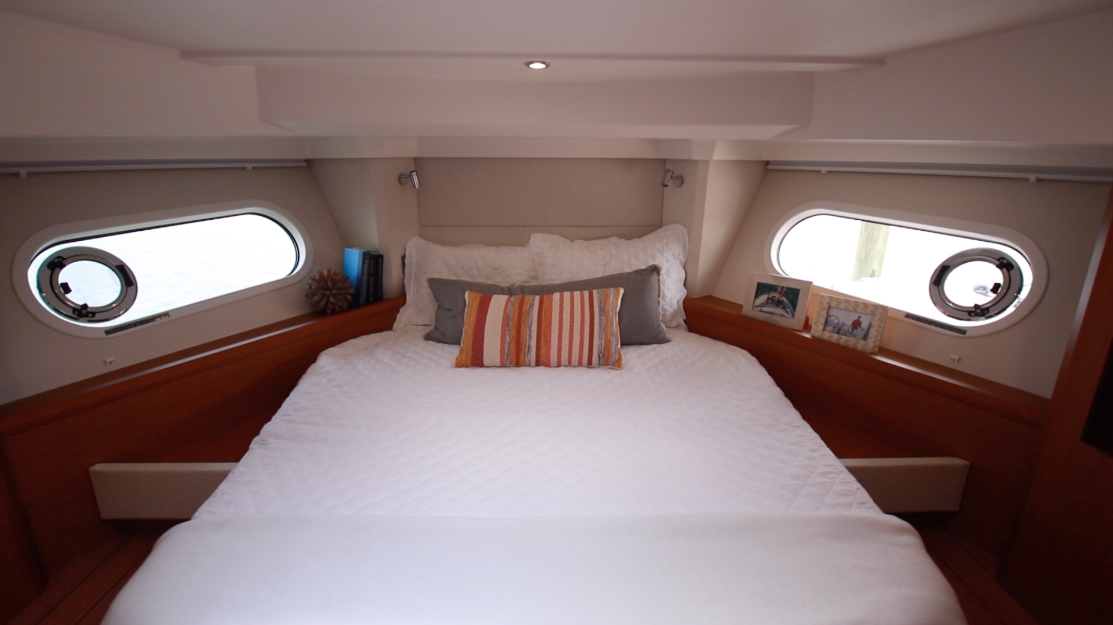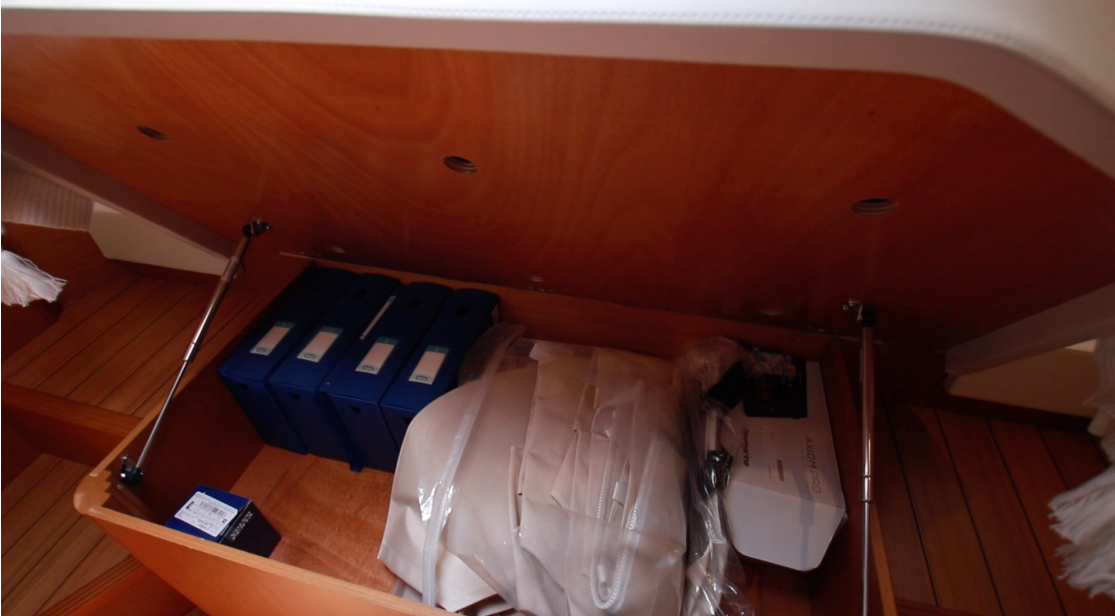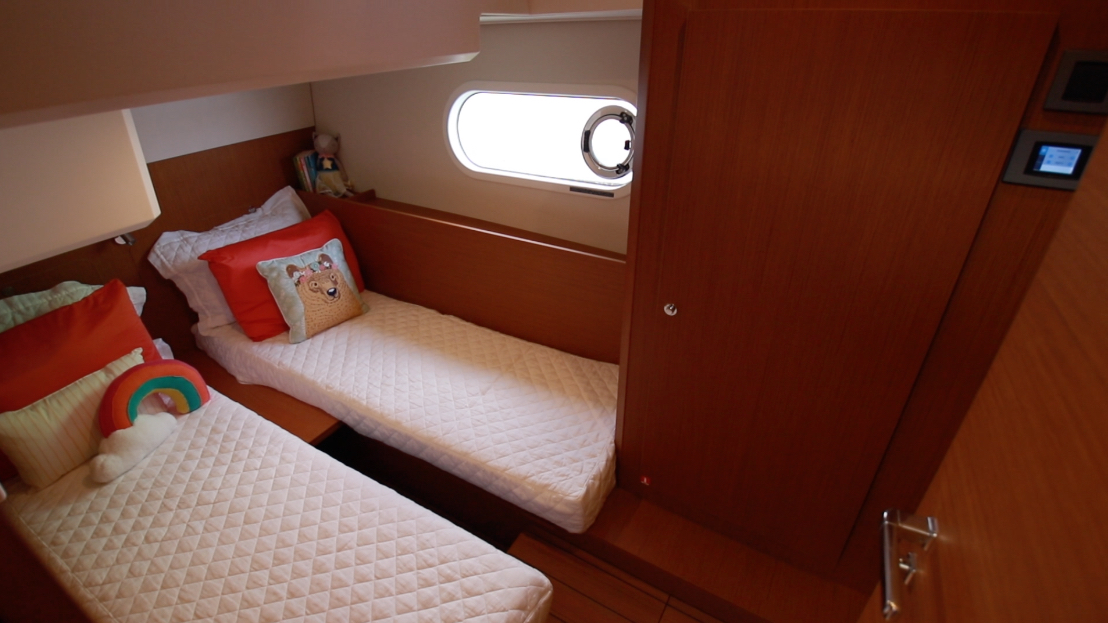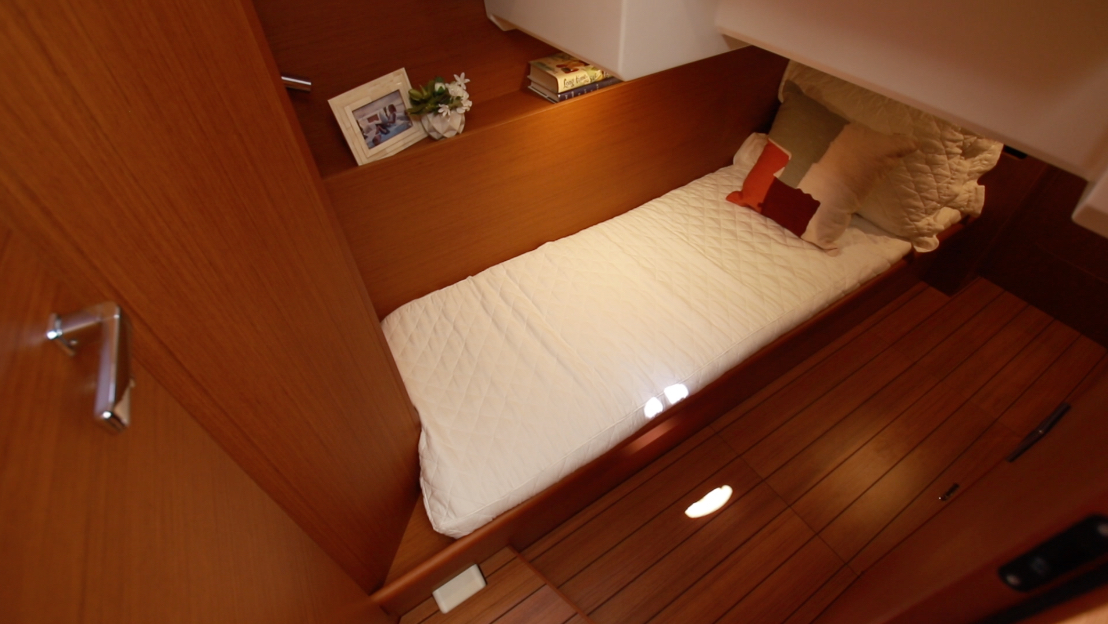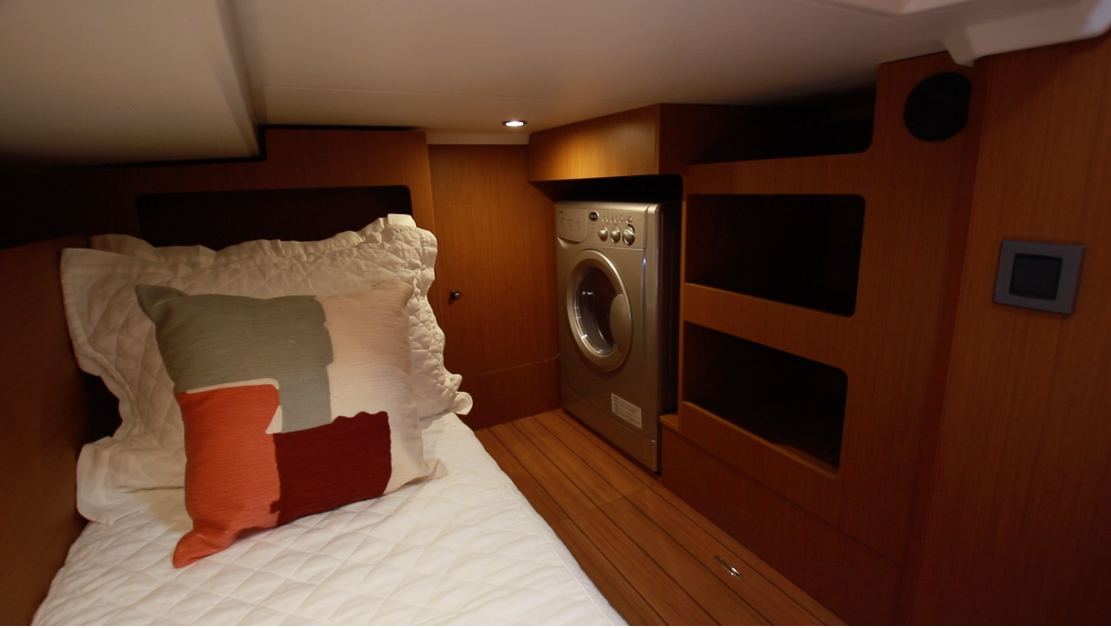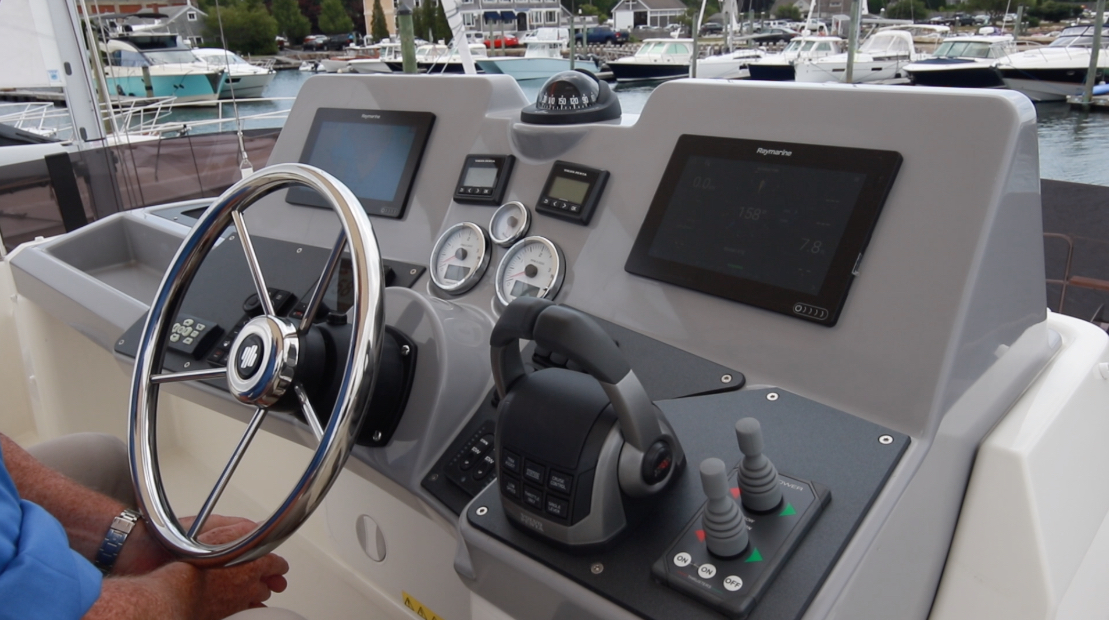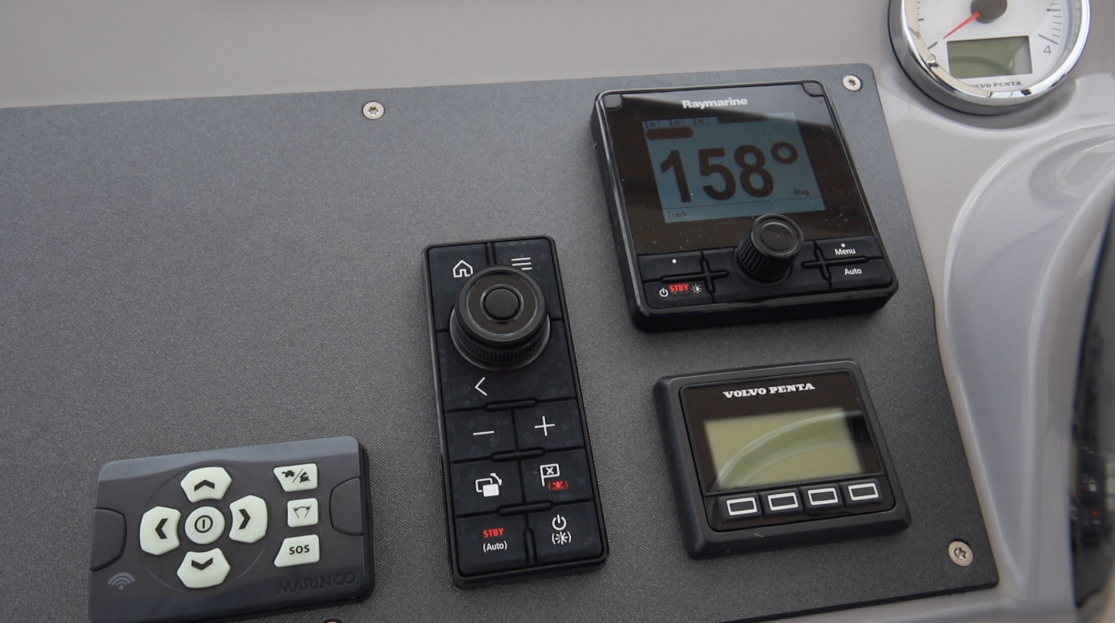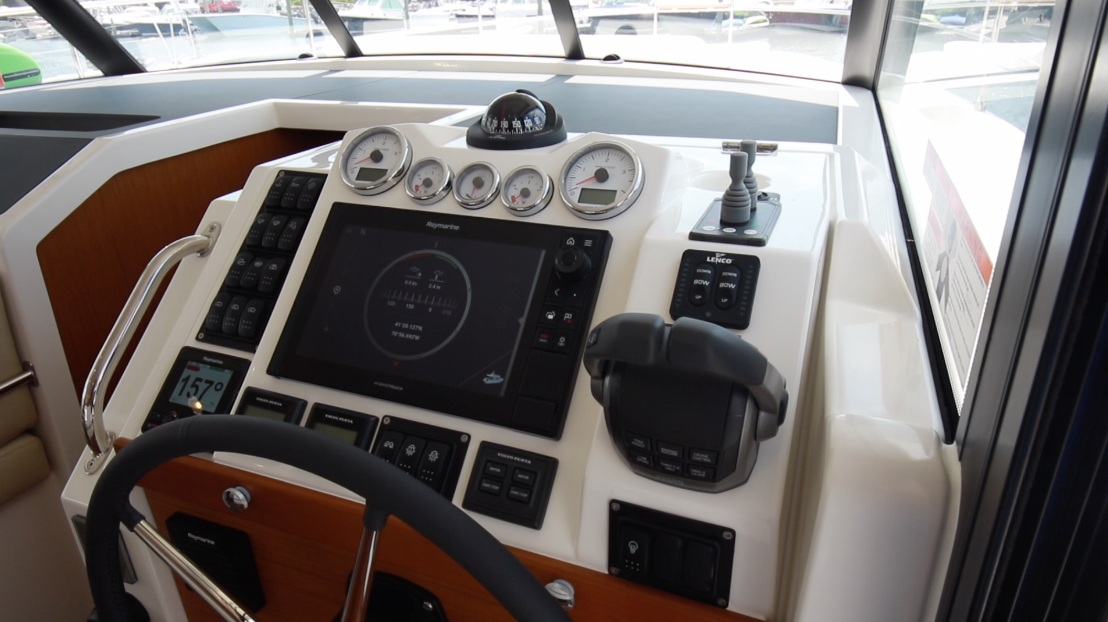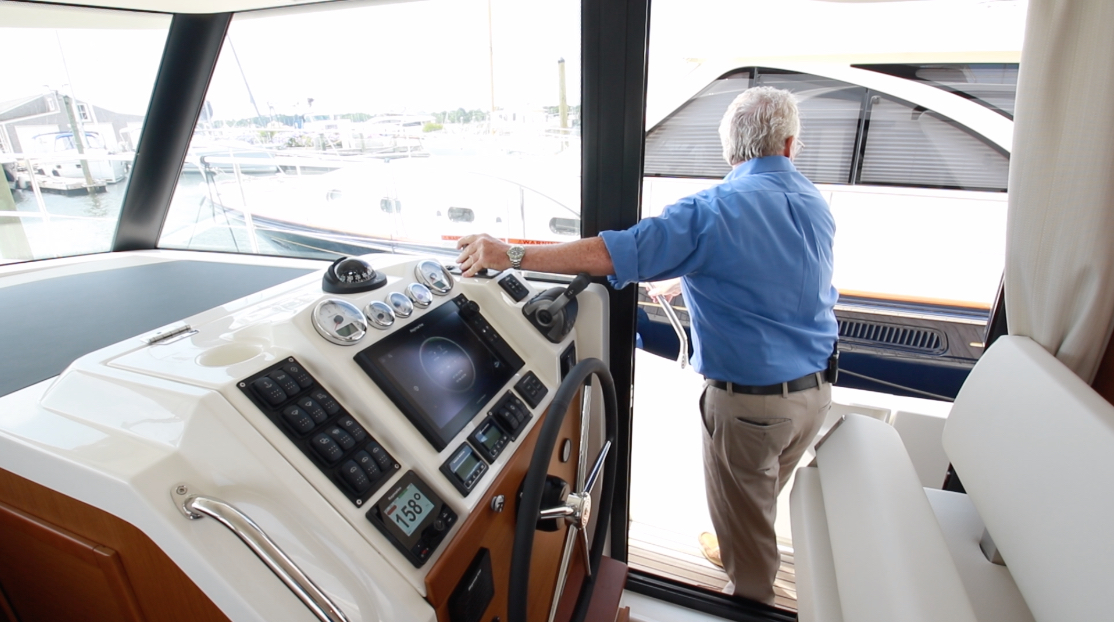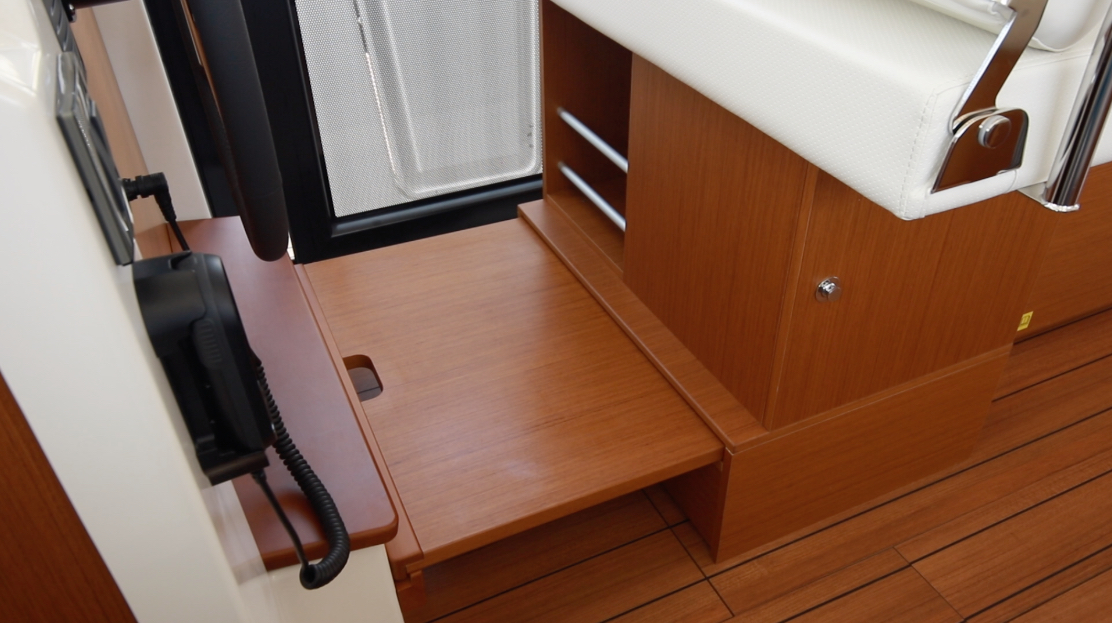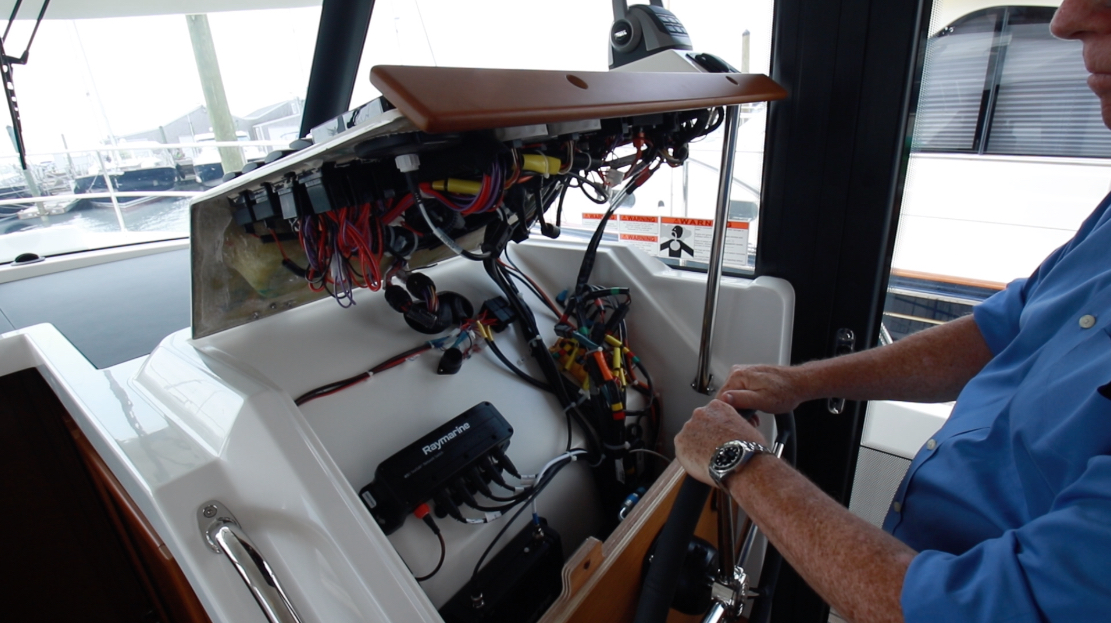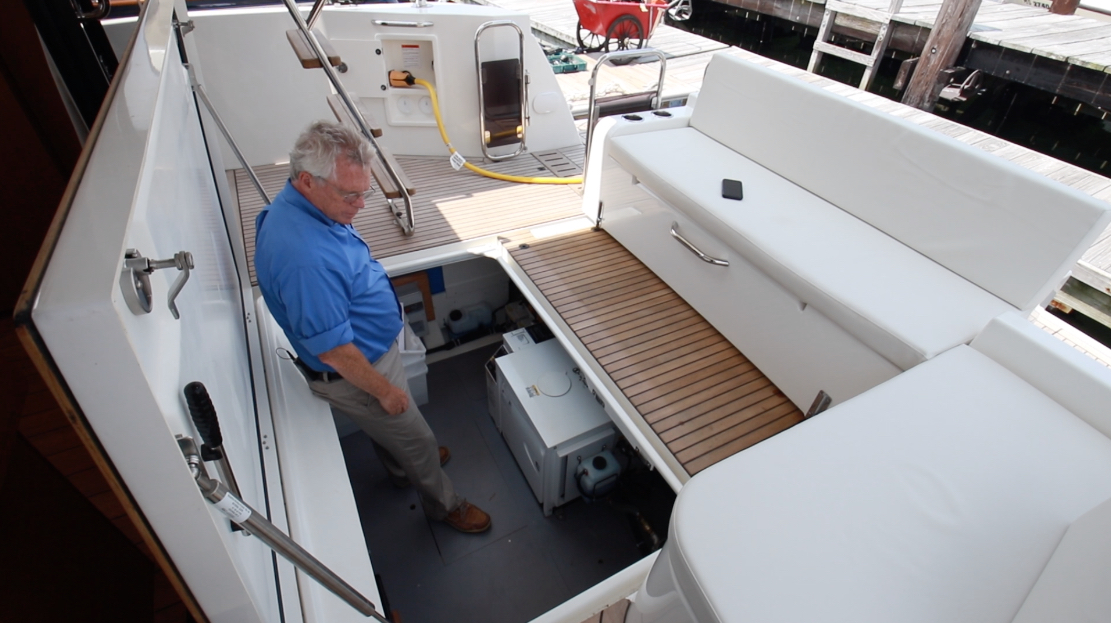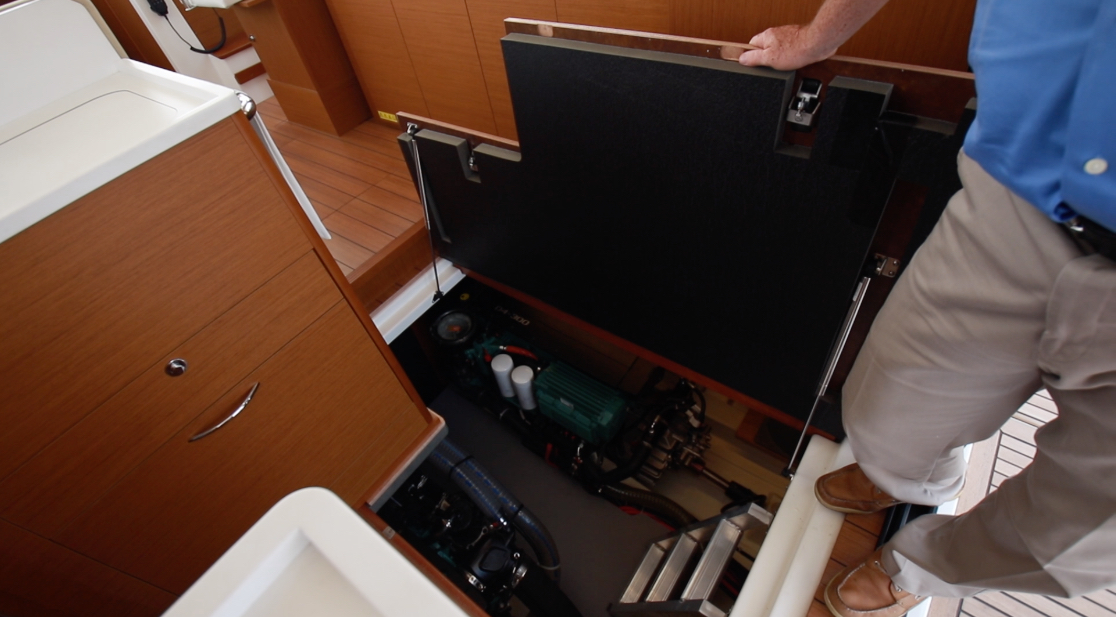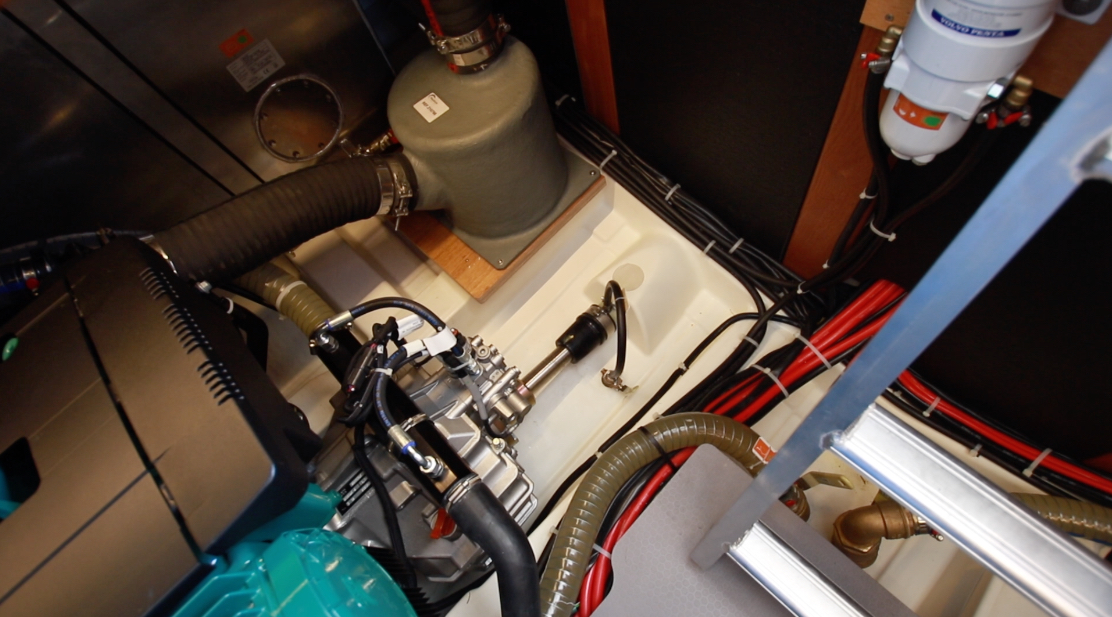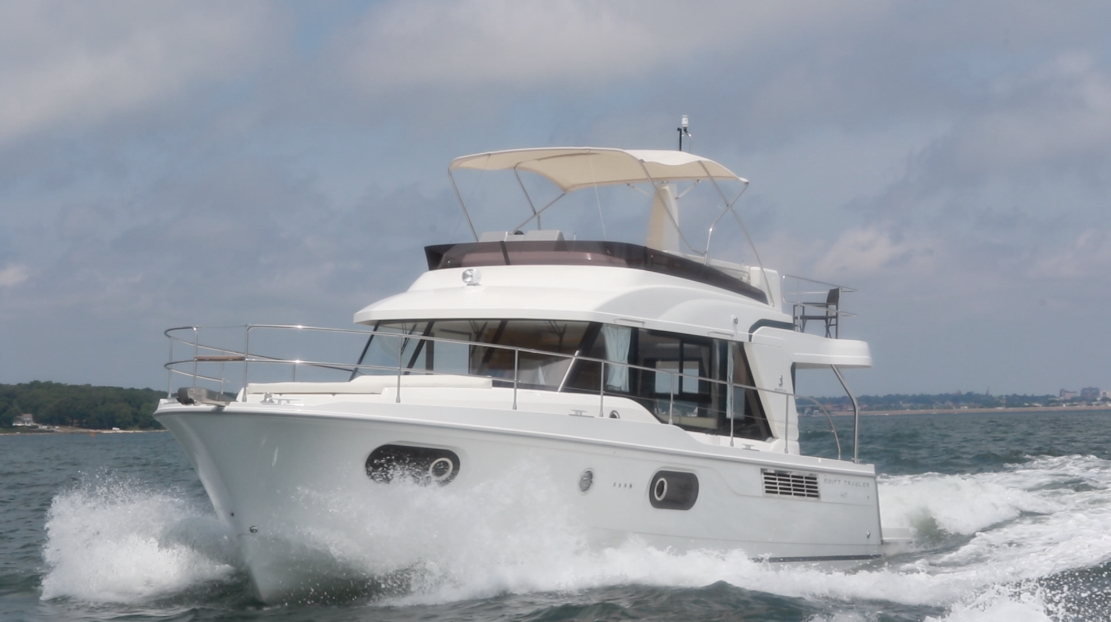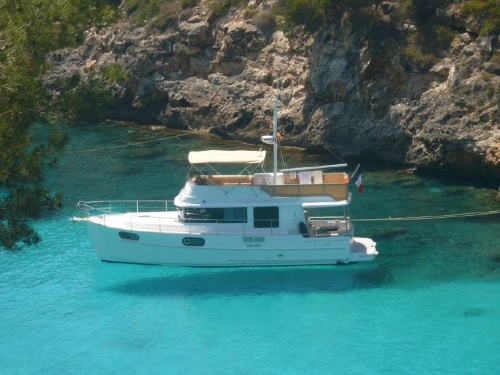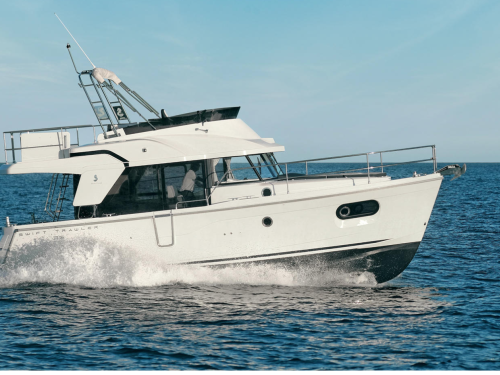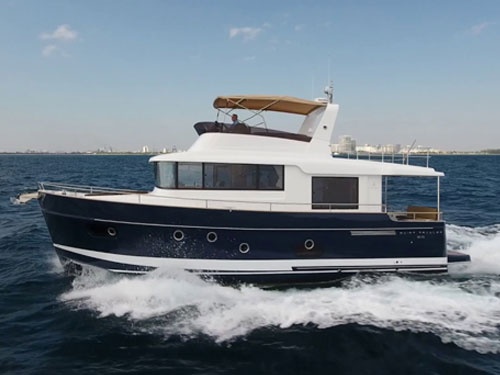Access More Boat Tests
Already have an account? Login
Beneteau Swift Trawler 41 (2020-)
2 x 300-hp Volvo Penta D4
Brief Summary
The Swift 41 is the latest addition to the popular Swift Trawler lineup that now encompasses seven different models. The keyword here being "addition!" This is not an existing model that has gotten a few tweaks and a new name, it's an entirely new model. Swift Trawlers are characterized by their semi-displacement hulls and all of the models can go over 20 knots.
Test Results
| RPM | MPH | Knots | GPH | MPG | NMPG | STAT. MILE | NM | dBa |
|---|---|---|---|---|---|---|---|---|
| 600 | 4.6 | 4 | 0.6 | 7.6 | 6.6 | 2109 | 1833.8 | 64 |
| 1000 | 6.1 | 5.3 | 1.2 | 5 | 4.4 | 1402 | 1219.2 | 65 |
| 1250 | 8.2 | 7.1 | 2.1 | 4 | 3.5 | 1112 | 967.3 | 67 |
| 1500 | 8.6 | 7.4 | 3.2 | 2.7 | 2.4 | 755 | 656.4 | 68 |
| 1750 | 9.8 | 8.5 | 5 | 2 | 1.7 | 545 | 474 | 69 |
| 2000 | 11.1 | 9.6 | 7.8 | 1.4 | 1.2 | 394 | 342.6 | 70 |
| 2200 | 11.5 | 10 | 10.6 | 1.1 | 0.9 | 302 | 262.4 | 74 |
| 2400 | 13.3 | 11.5 | 12.8 | 1 | 0.9 | 288 | 250.3 | 73 |
| 2600 | 15.6 | 13.5 | 15.6 | 1 | 0.9 | 278 | 241.8 | 74 |
| 2800 | 18.8 | 16.3 | 17.7 | 1.1 | 0.9 | 296 | 257.6 | 75 |
| 3000 | 20.7 | 18 | 21 | 1 | 0.9 | 273 | 237.8 | 76 |
| 3200 | 23.5 | 20.4 | 24 | 1 | 0.9 | 272 | 236.8 | 77 |
| 3400 | 26 | 22.6 | 27 | 1 | 0.8 | 267 | 232.4 | 78 |
| 3500 | 28.1 | 24.4 | 31 | 0.9 | 0.8 | 252 | 218.8 | 79 |
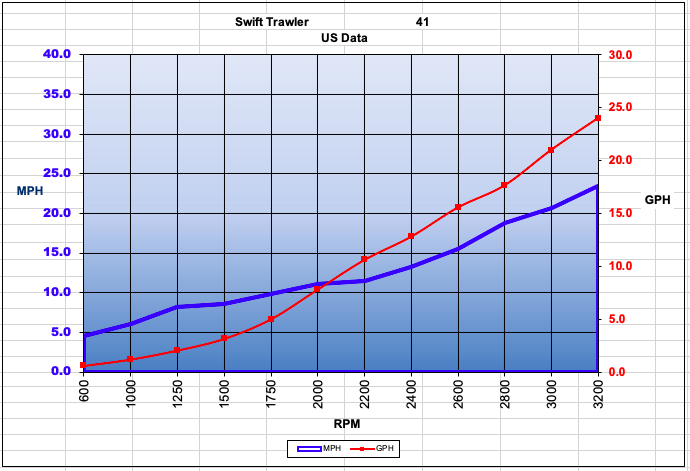
Specifications
| Length Overall |
44'1" 13.43 m |
|---|---|
| Beam |
13'9" 4.20 m |
| Tested Weight |
27,112 lbs. 12,297.79 kg |
| Draft |
3'9" 1.15 m |
| Bridge Clearance |
19'1" 5.81 m |
| Fuel Capacity |
309 gal. 1,169.69 L |
| Water Capacity |
106 gal. 401.25 L |
| Total Weight |
27,112 lbs. 12,297.79 kg |
Acceleration Times & Conditions
| Time to Plane | 8.1 sec. |
|---|---|
| 0 to 30 | 10.9 sec. (0 to 20) |
| Load | 3 persons, 1/3 fuel, 50 lbs. of gear |
| Climate | 79 deg., 95 humid., wind: 5-10 mph, seas: calm |
Engine Options
| Tested Engine |
2 x Volvo Penta 300-hp D4 |
|---|---|
| Std. Power |
2 x 270-hp Volvo Penta D4 |
| Opt. Power |
2 x 300-hp Volvo Penta D4 |
BENETEAU Swift Trawler 41: The company gives birth to a new addition to the lineup.
By Capt. Steve Larivee
This latest iteration of the Swift lineup also comes with a number of firsts. Most notably, the Swift 41 is the first of the line with an aft galley. She also comes with three staterooms, which is a bit remarkable considering the smallest model to come with three staterooms was previously 45’ (13.72 m) in length, so the decision process would have started with the Swift 47 or Swift 50. The third stateroom on this boat will always be present, but there’s the choice of making it a stateroom, repurposing it for storage, or even office space. It’s also the first with a dedicated U-shaped dining area that really opens it up to gatherings on the main deck.
That last feature of the main deck dining area represents some smart thinking on the part of BENETEAU. This model is also available in a sedan version, and that means that this improved main deck social zone takes on a whole new meaning and significance. There’s also a host of options with a sedan version to consider for the top of the hardtop. Options such as solar panels, a skylight, kayak or board racks.
The only other model to be offered as a sedan was the Swift 34. However, with over 400 of that model sold, only four were ordered in the sedan version. This was probably due to the fact that there was no real gathering area near the helm. Now that has changed with this new 41, so it will be interesting to see if the sedan version has more appeal, particularly to those needing more bridge clearance in their travels.
Cockpit
Let’s begin our tour of the 41 in the cockpit. At first, it seems a tad Spartan. There’s L-seating to port and across the stern. The teak deck is a 6” (15.24 cm) step down from the sliding glass doors to the interior. A ladder is to starboard that leads to the flying bridge.
It’s a simple matter to increase the useable space, however. Simply lift two barrel-style latches at the base of the aft seating and then it can slide back a full 16” (40.64 cm), significantly adding to the usable space. Increase it even more by removing two thumbscrews at the base of the ladder to the flying bridge, and then it too can be slid ahead and out of the way. Now the space is wide open to accommodate more guests, a removable table, and even deck chairs. Storage is under the seats, including storage for the propane bottle that feeds the galley appliances.
The entire aft deck is protected by the extended flying bridge deck 7’1” (2.16 m) off the main deck. It includes a grab handle and LED lights. Additionally, there’s a recess around the perimeter that will accommodate roll-up curtains, giving the area a much cleaner look when those are not deployed.
Platform
The swim platform is accessed from a pair of stainless-steel framed acrylic gates to starboard. It’s actually molded into the hull so there’s a lot of heft to it. If a tender or PWC is in the plans, it’s well suited to the task, but a launching mechanism of sorts will be required. There are plenty of aftermarket options, including davits, that can easily be accommodated. Swift also includes a lift system in the options list. With the cockpit seating slid forward, there’s a full 3’8” (1.12 m) of available storage space.
The teak decking is all on a single level, from the cockpit aft, so no stub hazards. To starboard, there’s a robust swim ladder under a concealed hatch, and when deployed, there are large grab handles to ease reboarding. A freshwater shower is just alongside the gate to the aft deck.
Bow
There are two side decks and the Swift 41 has an asymmetrical layout. So the port side deck has a 16” (40.64 cm) average width and is accessed up two steps, while the starboard side has a flush deck and a 19” (48.26 cm) average width. The starboard side also has 28” (71.12 cm) high bulwarks and an acrylic door can be closed off to add protection to the aft deck. Overhead protection comes out 23” (58.42 cm). A midship cleat is mounted atop the caprail. There’s a boarding gate across from the helm side door and three 9” (22.86 cm) steps allow access to the bow area.
At the bow, side rails that top out at 30” (76.20 cm) and mount to a 7” (17.78 cm) toerail provide the needed protection. A sunpad is mounted atop the trunk cabin that measures 68” (172.72 cm) x 81” (205.74 cm). It includes headrests that are in a fixed position and, as usual, we’d like to see them adjustable into chaise lounge positions.
Fully forward, the ground tackle consists of two 12” (30.48 cm) cleats flanking the anchor roller that is recessed between sections of toerail. A Lewmar windlass will provide the heavy lifting. Hatches to the sides allow access to the storage/rode locker compartments, where we find 100’ (30.48 m) of chain and 150’ (45.72 m) of rope.
Flying Bridge
The flying bridge is expansive on the 41, taking up almost 2/3 of the boat’s length. The main gatherings will take place ahead of the entry. An L-shaped settee is to starboard, and it wraps around a pedestal table. Across is an aft-facing chaise lounge and the table expands to reach all the way over to this side, so full dining capability is a non-issue. Both of the forward seatbacks are reversible so these seats can also be forward-facing to flank the center-mounted helm seat. Overhead, a Bimini top includes LED light strips.
The aft section of the flying bridge is a 45.56-sq.-ft. (4.23-sq.-m.) open deck waiting to be populated with deck chairs. Surrounding rails are 34” (86.36 cm) high. Ahead and to port is a grilling station with an electric grill, sink, refrigerator, and trash receptacle.
Galley
As we move inside, there’s an airy feel to the 41 that makes it feel much larger than it actually is. Some builders use subtle tricks such as mirrors in key areas to get that feel, but in the case of the 41, it’s the huge windows and roomy layout. There’s no squeezing by anything to get from one spot to another. It’s so well-lit that the inside really blends with the outside.
The aft galley is U-shaped, and Corian counters are highlighted and include raised edges. A covered double-basin sink is forward. In the left forward corner is a hatch held open by gas-struts. Inside is a dish drying area with sorters inside. To port is a three-burner propane stove with an oven below. These can be optioned out for electric versions, and in that case, the oven will be replaced by a microwave. Aft is more open serving area, and a cover is over a trash receptacle that can be removed by an access hatch to the aft side. Storage is plentiful and located above and below the counters. Facing the cockpit is a flip counter that can add to the serving area, as well as allow access to the trash receptacle.
So, missing from this equation is refrigeration, but fear not. It’s just across to starboard in cabinetry with nicely finished Alpi wood. The refrigerator/freezer is aft, and just ahead is a cabinet housing storage and an icemaker just under an expansive serving area. Still, more storage is just aft of the fridge, and ahead, against the helm seat.
Salon
Just ahead, and up a 5” (12.70 cm) step, is the salon. With the galley aft, BENETEAU was then able to not only have a more dedicated dining area, but the seating is now in close proximity to the helm. In other words, the captain doesn’t have to be sequestered and alone when underway anymore. All the guests can join in the voyage. The transition ahead is made safer in a seaway by the overhead grab rails that run from the galley to the forward end of the salon. The overhead is 6’6” (1.98 m) off the deck.
The main gathering area is to port in the form of U-shaped seating on an elevated platform surrounding a satin-finished table on dual pedestals. Large windows to port and starboard add plenty of natural light when combined with the large windshields. For ventilation, the port side windows are opening, and to starboard is a sliding door to the side deck. This large seating area at the table is unique to this model and frankly, it’s a welcome addition.
The area can be converted to an extra berth in a pinch, and two things are different about how BENETEAU chose to do it here. First, the table isn’t on a hi/lo pedestal. Those tend to be wobbly and not as strong as a dining table should be, so it’s a switch to shorter pedestals and a filler cushion to make the transition. When other manufacturers have a convertible settee, all the windows get curtains to close off the whole main deck, all the way around. Here, BENETEAU just closes off the berth area. Tracks around the entire settee allow the space to be surrounded by privacy while the rest of the space is still usable. In other words, you can still walk from the companionway and out the aft door without interrupting the privacy of whoever may be in the berth. Pretty slick!
As for fit and finish, the decking is a BENETEAU laminate flooring that we’ve seen before, but here it has an added texture that not only gives it a non-skid feature, it’s also easier on the eyes.
Lower Decks
Because the 41 is driven with straight shafts, several decisions have been made. The engines are located in the galley area, and being so far forward, they improve the lateral stability of the vessel. It also means that the larger master is moved forward to the bow. Let’s start there.
Master Stateroom
The master has the usual characteristics of an island berth measuring 79” (200.66 cm) x 60” (152.40 cm) and is accessible from both sides. The open and airy feel continues here with the 6’4” (1.93 m) along with hull side windows and opening ports to both sides, and still, more natural light is added from the overhead hatch. Storage is to the sides of the berth, to both sides of the entry in hanging lockers, and still, more is accessed under the berth by lifting at the foot.
A clever and welcome design feature is the split head arrangement. Flanking the entry door are two more doors. The one to starboard opens to the shower that includes an opening port and overhead hatch, providing ample ventilation. To port is the water closet with a freshwater flush toilet, vessel sink, mirror, opening port, and still another overhead hatch. This arrangement allows for two people to get ready for a night on the town at the same time, and one person showering doesn’t equate to steaming the entire head into uselessness.
The thoughtful touches of fit and finish continue on this lower deck. All door hardware is heavy-duty stainless-steel. Latches remain retracted when the doors are open so there’s no snagging on shirts or sweaters. When the doors are closed, magnets draw the latch out. Gaskets run the perimeter of all door openings to eliminate rattling while underway.
Guest Staterooms and Day Head
To port, the stateroom includes twin berths and a filler cushion can convert it to a queen. There are two opening ports here, one integrated into the hull side window. Across the companionway is the day head. This is a wet head and fully featured, including vents for heat and air conditioning. And just abaft is the remaining stateroom. This is a single with still another opening port. Some customers, such as the distance cruisers, will opt for using this as more of a storage/utility room. It also includes space for an optional washer/dryer.
Operations
Upper Helm
The flying bridge helm has been given a significant refresh for this new model. It’s center-mounted. Two 12” (30.48 cm) screens are to the sides. The center panel includes the two EVC engine displays, analog tachometers and a rudder angle indicator. The engine controls are to the right, and outside of the binnacle are the twin thruster joysticks. The helm seat is a bucket-style that swivels.
Lower Helm
Being that the flying bridge is not enclosed, the lower helm becomes a priority in inclement weather and therefore, is not optional. It’s starboard mounted and well laid out.
The compass is top center-right in line with the wheel. Analog gauges are just below with the ever-important rudder angle indicator smack in the middle. Below, a 12” (30.48 cm) display will receive the bulk of the operator's scan. It also includes BENETEAU’s proprietary Ship Control that allows for controlling all the vessel’s electrical switching from this location. For more immediate items, such as wipers, etc… there are still electrical switches at the helm, and of course, light switches at every stateroom.
Below are the Volvo Penta EVC displays that are also tied into the MFD. The autopilot is off to the left of the panel. To the right, there’s an extended panel housing the throttle quadrant, and the trim tabs.
Up top are the two thruster control sticks. It’s nice to see that this model uses a control for the thrusters that features a single power button to activate both the bow and stern thruster simultaneously. Previous models had individual buttons with one hidden behind the aft stick, and it would always bite me on docking. No more.
The steering wheel is a 24” (60.96 cm) destroyer style that is mounted on the vertical. Five turns from lock to lock keep maneuvers docile. Of course, our favorite feature is the sliding side door. It latches into two positions and gives a full view of the starboard side while still being able to keep hands on all the controls.
Visibility is spectacular through the three large 34” (86.36 cm) x 34” (86.36 cm) windshields with their narrow mullions. Glare is knocked down sufficiently, thanks to the extended brow just above that juts out a full 22” (55.88 cm). Defrost vents are also provided.
Lazarrette
The aft deck hatch lifts to expose the spacious lazarrette. Inside, there are the water tanks to both sides. Aft and to center is the 7.5-kW generator. It includes an exhaust diverter that discharges the water from under the boat, making the Swift Trawler 41 a much better neighbor in the anchorage.
Engine Room
The engine room is accessed from hatches in the galley deck. With straight shafts, there’s more of a balance that makes the boat much more comfortable overall. With the throttles pinned, she’ll accelerate at a more level attitude, so no forward visibility is lost. She’s also much kinder in pitch when encountering seas. Cruise attitude is also more level than expected.
Inside the engine room, a ladder leads between the twin 300-hp Volvo Penta D4 diesel engines. There is easy access to the fuel filters at the aft bulkhead. All the checkpoints are in the center walk space. Fuel tanks are to both sides and there’s easy access to the fuel shutoffs. All hoses are properly double clamped in accordance with ABYC standards. Most notable is that there’s a full inner liner to the compartment so we’re not seeing raw fiberglass in the bilge areas.
Test
Out on the water, the twin 300-hp Volvo Penta D4s pushed the 41 to a top speed of 24.4 knots at 3500 rpm. If we dialed her back to 2800 RPM, we reached her best economic cruise at a planing speed of 16.3 knots. At that speed, she was showing a fuel burn of 17.7 GPH and a range of 257.6 nautical miles. Of course, while still holding back a 10-percent reserve of the boat’s 309-gal (1,169.7 L) total fuel capacity.
Trawlers are also about distance cruising. This model stayed on plane right on down to 10.2 knots, and she can keep going at that speed for 269.5 nautical miles. But if we took her off plane and cruised at 7.1 knots, that revealed a range 967.3 nautical miles, again while keeping a 10-percent reserve of fuel in the bank.
Handling
Aside from the fact that I've really got heart and soul appeal for the trawler lifestyle, I just enjoy the slow pace of a trawler. At 7 knots, we were going almost 1,000 miles, which is a great range for something like this. We didn’t have much chop during our test, but crossing wakes of our camera boat or crossing our own wake showed no spray and no hull slap whatsoever. When she comes down a wave, she’ll throw spray way out to the sides. There’s not too much wander in following seas, and she’ll track straight and true. If you hit it a little bit on the side, it'll start pushing her stern around but that's easily combated with just a little bit of rudder, and it does not take much.
When coming up on plane, she accelerates in a level attitude so there's really no bow rise to speak of. I wasn't using the trim tabs. They seem to be more for leveling if you have an uneven weight distribution on the boat.
Observations
With over 1,300 Swift Trawlers built, the line is obviously well-loved. There’s a dedicated mindset to the trawler lifestyle, but BENETEAU takes that in a new direction and doesn’t limit the available speed to the typical 10 - 12 knots. Instead, we have the option to cruise nearly 1000 NM to a remote location and then zip around that location to do more exploring. Conversely, we can also make better headway in getting to that destination and loiter around for weeks without having to refuel.
Even more interesting is the fact that when one goes through the choices of which Swift Trawler to purchase, the decision isn’t so much about what size to get, but what function the vessel is to accomplish, as each model has its own purpose. You might find that the 41 fits your family and the way you intend to use it, better than a 50. The choices are vast, but the big difference here is, the salesman won’t try to stranglehold a new buyer into getting the biggest boat he or she can. Rather, the purchase process will start with helping you define your use, and then targeting the model to fill that desire.
That’s the Swift Trawler mindset.

